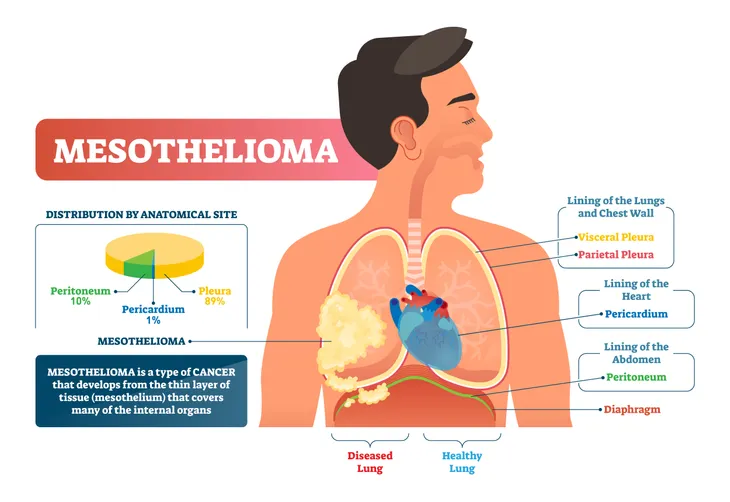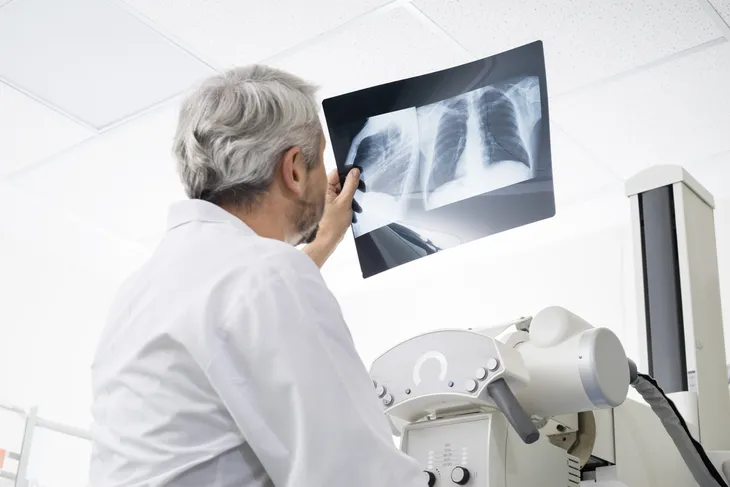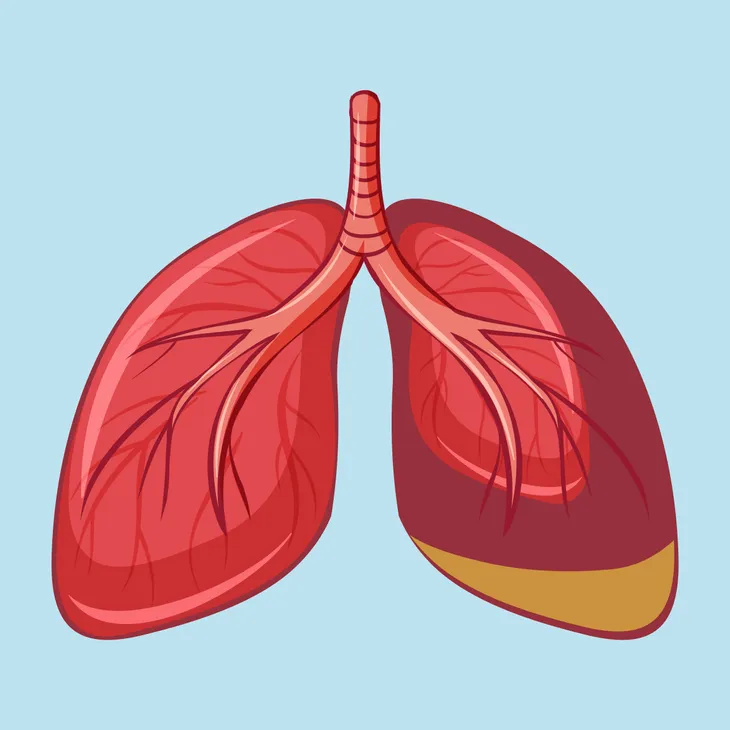Mesothelioma is a rare type of cancer that is typically caused by exposure to asbestos. It’s an “aggressive, malignant cancer caused when inhaled asbestos fibers lodge in the lining of the lungs (pleural), abdomen (peritoneal), or heart (pericardial),” writes Asbestos.com.
After a person ingests asbestos, it can change their DNA, causing cells to divide out of control, which leads to cancer. However, it can also be attributed to zeolites, radiation, SV40 virus, or genetics. While this type of cancer might sound rare and is not often heard about, according to the American Cancer Society, there are roughly 3,000 new cases of mesothelioma recorded each year in the United States.
To get better informed on the topic, here’s an in-depth look at the staging process and what to expect during each stage of mesothelioma…
1. Different Types of Mesothelioma
There are four different types of mesothelioma, but pleural is the most common form. It accounts for about 75-percent of all cases, says Asbestos.com. Each type of mesothelioma is named after where it is located in the body. Pleural mesothelioma forms in the outer lining of the lungs and inner lining of the chest cavity. The first signs of pleural mesothelioma are chest pain and shortness of breath. Peritoneal mesothelioma is the second most common type of mesothelioma and accounts for about 20- to 25-percent of all cases. It originates in the abdomen, affecting the protective lining of the abdominal cavity.
Pericardial is the third type of mesothelioma and is extremely rare. It begins in the membrane surrounding the heart, also known as the pericardium. It may cause chest pain, an irregular heartbeat, pericardial thickening, and pericardial effusion (fluid buildup). The last form, metastatic mesothelioma, is the most severe. This form of mesothelioma is when the cancer has spread throughout the body from wherever it originated, causing a slew of very severe and serious symptoms such as coughing up blood and nerve dysfunction.
Most mesothelioma patients are 75-years of age or older, because it can take anywhere from 20- to 50-years after their first exposure to asbestos for mesothelioma to appear. More often than not, Asbestos.com explains that the patients are men who worked in heavy industry and construction which is where asbestos exposure is most commonly found.
2. The Stages
The stages of mesothelioma are defined by how the cancer grows and spreads, but pleural mesothelioma is the only type that has an approved staging system. Luckily, it’s also the most common type of mesothelioma, so it is what we’ll focus on in this article. “Mesothelioma can be categorized into one of four stages, which classify how far the cancer has progressed in the body,” writes the Mesothelioma + Asbestos Awareness Center (MAAC). “Mesothelioma staging is part of the diagnostic process and a critical component of developing a patient’s treatment plan.”
It’s also important to note that there are several different staging systems that have been developed and used over the past few decades. The most common are the Butchart system, Brigham system, and Tumor, Node, Metastasis (TNM) system. We aren’t going to focus on one over another because they are all quite similar. But rather, here’s an overview of how mesothelioma is generally categorized. For the most part, across all staging systems as the number gets higher, the cancer is more advanced.
3. Stage 1: Symptoms
Not surprisingly, stage 1 is the earliest stage of the disease, where the cancer is still localized to one area of the body. This means the cancer has not spread past wherever it originated, which as we just previously discussed can either be in the lungs, abdomen, or heart.
When it comes to pleural mesothelioma, Asbestos.com points out that there might not even be any symptoms at all, because the tumors are too small to cause any kind of pain or shortness of breath. In some cases, they will resemble other conditions, such as pneumonia or asthma, with a slight tightness in the chest, according to the Mesothelioma Group.
For peritoneal mesothelioma, there will be a similar pressure, but it will be felt in the abdomen and is usually caused by excess fluid buildup. “Outside of chest or abdominal pressure, symptoms caused by stage 1 mesothelioma are general, a characteristic which makes it difficult for doctors to attribute them to mesothelioma,” writes the Mesothelioma Group. The source goes on to list a number of common symptoms during stage 1, including chest pain, chest pressure, fever, abdominal pain, shortness of breath, persistent cough, and nausea.
4. Stage 1: Treatment
Since this stage doesn’t often exhibit many signs and symptoms, it’s very rarely diagnosed during this stage. If the cancer is found during this stage, it’s often because the patient was having a routine X-ray for a completely separate condition, explains the MAAC.
Treatment options available during stage 1 are curative, including surgical resection. In addition to this, life expectancy is also the best, with an average survival of 21- to 40-months, explains the MAAC.
5. Stage 2: Symptoms
Similar to stage 1, stage 2 is still considered to be an early-stage cancer, because it hasn’t spread far from where it first originated. In the case of pleural mesothelioma, this means “the cancer is either only present in the pleura on one side of the chest or it has spread locally into the lung itself or the diaphragm,” writes the MAAC. The source also notes that all staging systems agree the cancer can still be resected during stage 2.
The symptoms are also similar to stage 1. During stage 2, the symptoms are still quite mild and can sometimes be confused with other diseases, such as pneumonia or chronic obstructive pulmonary disease (COPD). “If you’ve received a stage 2 diagnosis, your main source of discomfort will be pressure resulting from the buildup of fluid in the lining of your lungs, abdomen, or heart. Where you feel this pressure depends on the location of the mesothelioma,” writes the Mesothelioma Group.
The source goes on to list the following as common symptoms during stage 2: chest pain, chest pressure, fever, shortness of breath, persistent cough, and weight loss.
6. Stage 2: Treatment
While all the staging systems are slightly different, they all agree that stage 2, can still be resected. This means there are still some treatment options available, such as surgery or chemotherapy, that give the patient a longer life expectancy than either stage 3 or 4.
Of course the method of treatment depends on what type of mesothelioma the patient has. In the case of pleural mesothelioma, there is either extrapleural pneumonectomy (EPP) or a pleurectomy with decortication (P/D), explains the Mesothelioma Group. “Patients with peritoneal mesothelioma can have cytoreductive surgery; when paired with chemotherapy, this procedure has extended survival times to 5-years and beyond,” writes the source. “Regardless of the location of the mesothelioma, your doctor may also give you palliative treatment designed to relieve discomfort caused by symptoms.”
The source also notes that chemotherapy and radiation therapy are sometimes a treatment option for stage 2, but whether or not they will be effective can only be determined by a doctor, as the patient might still need multimodal therapy.
7. Stage 3: Symptoms
Stage 3 is considered by specialists to be an advanced stage of mesothelioma, because the cancer has spread from either the lining of the lungs to the chest wall, abdomen, or pericardium, says the Mesothelioma Group. At this point, the cancer cells have invaded the nearby lymph nodes on one side of the chest. Even though we’re now making our way down the list into the higher numbers, the source states there are still treatment options available that can improve the patients quality of life, as the cancer is still localized to one side of the body “or to lymph nodes located at a distance from the primary tumor.”
Unlike stages 1 and 2, there are some more obvious symptoms that begin to appear, but again, they can still resemble other conditions, such as pneumonia or bronchitis. During this stage, medical attention is needed and often sought out by patients due to their uncomfortable symptoms. “Most stage 2 symptoms are caused by tumor growth, which produces excess fluid, scarring, and inflammation in the lining of the lungs, abdomen, or heart,” writes the source. “Scarring and inflammation restrict the movement of the lining of the lungs, causing pain and breathing difficulty.” Other symptoms that may appear are dyspnea, chest pain, weight loss, painful breathing, fever, and stomach pain, explains the Mesothelioma Group.
8: Stage 3: Treatment
The first step in treating stage 3 is to determine whether or not the patient should move forward with chemotherapy, surgery, or radiation. At this stage, the most they can do are palliative treatments that are meant to relieve any symptoms and discomfort. Both chemotherapy and radiation therapy are used as palliative treatments to shrink or slow the growth of tumors. “Doing so relieves the pressure caused by large tumors, buildup of excess fluid, and inflammation,” writes the Mesothelioma Group. At this stage, chemotherapy is commonly received as a pill or through an intravenous (IV) drip.
Radiation therapy can also be used to shrink tumors, but unlike chemotherapy, it is much more targeted. “Doctors use concentrated beams of radiation to kill cancer cells and keep the growth of tumors in check. Being able to focus the cancer-killing effectiveness of radiation on a tumor cuts down damage to healthy cells and, as a result, reduces side effects,” writes the source.
Most stage 3 patients are not cleared for curative surgery which means they will go on to have palliative surgery. “Doctors use palliative surgery to relieve discomfort caused by symptoms of mesothelioma, improving your quality of life,” writes the source. The following three procedures are used to treat stage 3 symptoms: pleurodesis (prevents the excess fluid from collecting in the lining of the lungs), thoracentesis (drains excess fluid from the pleural cavity, paracentesis (drains excess fluid from your abdominal cavity), and pericardiocentesis (drains excess fluid from your pericardial cavity).
9. Stage 3: Life Expectancy
During stage 3, life expectancy can range anywhere from 6- to 12-months. In some cases, this can be improved with palliative treatments, says the Mesothelioma Group. While curative treatment is likely not an option because the cancer has spread too far, there are things that could help, particularly in the form of clinical trials. A doctor will be able to determine if there are any clinical trials that the patient is eligible for. The source goes on to say that any new and emerging treatments could help improve this prognosis.
10. Stage 4: Symptoms
Stage 4 is the final stage for mesothelioma, and it’s reserved for the most dire cases. During this stage, the cancer has spread (or metastasized) to other organs and structures of the body, including the lymph nodes, far away from where it first originated, says the Mesothelioma Group. This means it’s spread throughout the chest wall, pericardium, and diaphragm.
Due to the severity of the cancer at this stage, the symptoms are more noticeable than ever. “This is due to the extensive growth of the tumor throughout both side of the body; at this stage, it can cause shortness of breath, chest pain, stomach pain, or anorexia,” explains the source. Other symptoms include fatigue, fever, night sweats, cachexia, ascites, and pleural effusion.
11. Stage 4: Treatment
Unfortunately, during this stage, the treatment options are limited and can only be used to improve quality of life, however long that might be. The cancer has spread too far and wide for any sort of curative treatment, but there are some palliative treatments available and clinical trials, of course. The Mesothelioma Group encourages all patients who have been diagnosed with stage 4 to get a second opinion before making any decisions about their treatment.
The treatments available are similar to stage 3, in the sense that they are all palliative. A patient may receive either radiation therapy, chemotherapy, or palliative surgery. The Mesothelioma Group explains that chemotherapy can either be administered through a pill or via an IV drip. The two most successful chemotherapeutic drugs for mesothelioma are pemetrexed (Alimta) and cisplatin.
12. Stage 4: Life Expectancy
The Mesothelioma Group explains that the prognosis for stage 4 is anywhere from 6- to 12-months. This is not to be taken literally though, because the source notes this is just a statistic. A patient’s life expectancy with come down to a number of different factors including the cell type and location of their mesothelioma. “You should interpret statistics related to stage 4 life expectancy as guidelines doctors use to determine which treatment options — palliative treatment, new treatments in clinical trials, or supportive care — will work best for you,” writes the source. Again, anyone diagnosed with stage 4 mesothelioma should get a second opinion from an experienced doctor.















